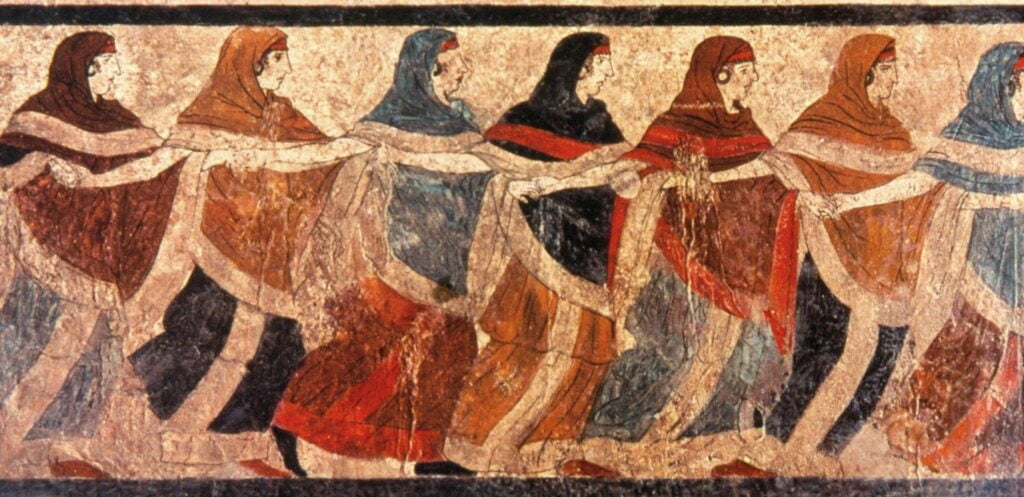di Alessandra Fumai
Describing a culture starting from the body, starting from the way in which bodies cadence the ritual and daily space, can provide a non-naive reading of social organizations different from ours.
When it comes to matriarchy and matriarchal culture we must, in my opinion, maintain a certain caution and allow ourselves to think of something quite different from what we are used to: a social configuration in which feelings, expectations and relationships had a different flavour. Starting from the contribution of Anna Llieva and Anna Sturbanova contained in the anthology dedicated to Marija Gimbutas and edited by Joan Marler, From the Realm of the Ancestors. An Anthology in Honor of Marija Gimbutas, 1997, and hereinafter made available in Italian, we can imagine and build reasoning around the themes of dance and the body, starting from their studies. In this essay, the authors present some ritual dances of ancient Bulgarian culture, expressed through mimesis with zoomorphic figures, which assist the dialogue with extra-human forces. According to anthropology's reading of it, dance, like other cultural products, expresses power relations, opposes or exalts them and is placed in the frame of social drama, as taught by Victor Turner. The need to govern the disturbing elements of life such as the changes of season, the crucial moments of birth, illness, growth and death has always led human beings to rely on ritual practice.
The aspect I would like to underline is how in this essay the body becomes a vehicle for the management of the sacred, a tangible text of the cosmic movement and a factual implementation of mythology, which is relived and re-enacted by the participants in the rite when it is incorporated . The perception and organization of reality itself are rooted in the experience of the body, which absorbs knowledge deriving from individual and social experience.
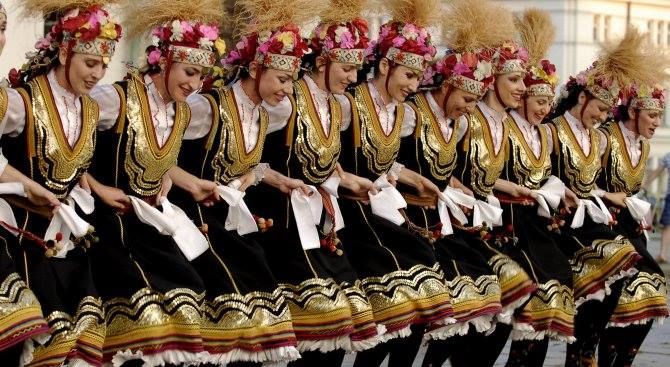
Layne Redmond in her wonderful book When the women played the drums (L. Redmond, 1997/2021) speaks of the celebration of the joy of the body combined with the sacredness of the ritual moment depicted in Roman art. The author searches ancient history for traces of musicians and percussionists who became the voice and vehicle of the sacred, in contexts where ecstatic music and dance were practiced by men and women. The affirmation of the patriarchy and of the Christian religion is accompanied by the suppression of female sexuality, the suppression of music and dance in rituals and above all the de-strengthening, up to the well-known witchcraft trials, of the female figure as a means of experience of the sacred.
If we are interested in the relationship between culture, body and movement, we know how dance can both reflect and shape social relationships.
What relationship did they have in ancient Bulgarian culture with the body? How was it experienced in terms of what we might call self-consciousness?
If it is possible to construct epistemology, to know from and starting from the body, every contribution to a history of dance and its link with women becomes precious, since it integrates knowledge as such.
The authors of the article we are dealing with state that "one of the main functions of ritual dance in folklore is to convey knowledge: knowledge of the structure of the world, of community life, knowledge of oneself, of the laws and governments of society , and knowledge of the mythological worldview”.
In this cultural context, the woman, as a specialist of the sacred or custodian of tradition, is superimposed on the earth, exalted in her generative and creative powers through symbolic acts that find their maximum expression in dances and songs: these practices are made up of a direct relationship with the landscape and with the supra-individual entities that preside over the flow of things.
As Pontremoli argues (A. Pontremoli, 2004) every form of dance is legitimized by the fact that it represents a response to a precise cultural instance, because it mirrors the society that produces it: the dancing body therefore presents itself both as a subject and as a social body . Choreography is both material and symbolic writing that can be read, even if this reading can sometimes be difficult, not univocal, certainly multiple and influenced by the gaze with which we appropriate it. History is told starting from the body, and this body and the discourses about it are historically determined.
The essay by Llieva and Shturbanova, who are contemporary to us, rekindles our attention to a History that has not had the first place in the institutions of knowledge, and which tells of another way of being in the world, interacting with it and flowing with it : a powerful and precious legacy of the female cultures of the ancient world who lived next to us. The use of singing, and of the body, makes these experiences dense, powerful and sensual to the extent that the entire sensory apparatus is involved in the ritual, practice and celebration. It is created, through these refined body techniques, a sort of mimetic community that finds its profound expression of action on the world and participation in the sacred, the numinous in the sharing of patterns of movement and vocality.
Zoomorphic images in the ritual dance of Bulgarian women in ancient European symbolism.
di Anna Llieva and Anna Shturbanova
Folklore Institute, Bulgarian Academy of Sciences, Sofia, Bulgaria, 1997
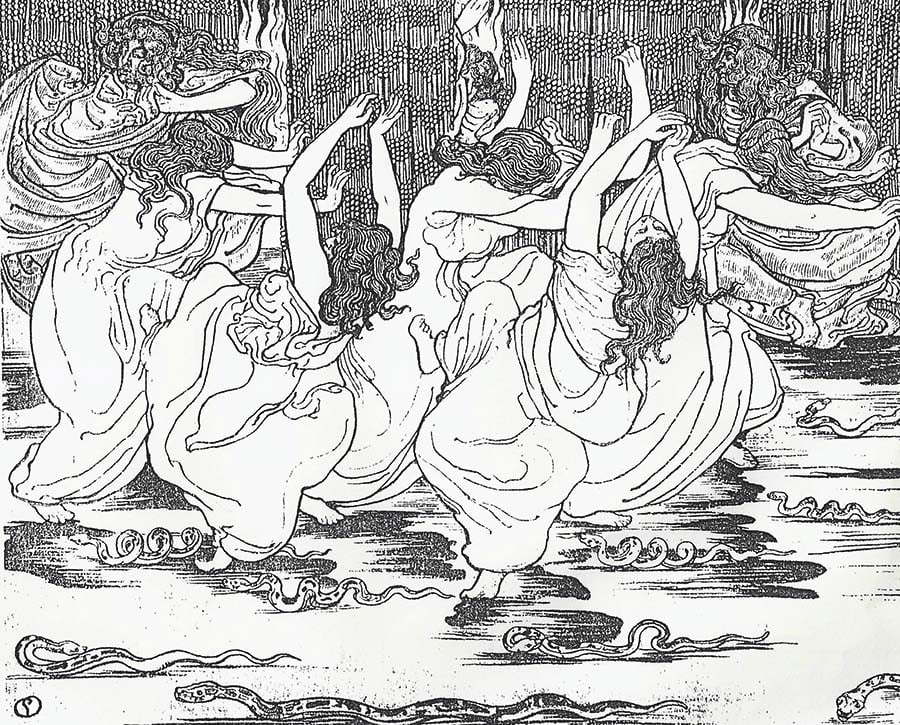
Before the historical and cultural upheaval of the 40s, Bulgarian folklore existed as a relatively independent cultural system within the fabric of traditional life in rural Bulgaria. The old men and women of the villages are still able to remember and tell about this lifestyle that is disappearing.
Our research is guided by the "holistic spirit" of dance. It is an ambitious and impressive task, considering that Bulgarian folk dance culture is distinguished by its great diversity of forms, rituals, concepts and beliefs. For this purpose, we have created our own interdisciplinary approach, suitable for the study of the numerous dances performed during festivities, and of the ritual dances still preserved in Bulgaria.
If the transition from Chaos al Cosmos is the intrinsic matter of mythology, these ritual dances express the profound meaning of archaic myths (both destructive and creative) through the movements of the human body and its interactions with natural and cosmic forces. In ancient times, dance was one of the most powerful and widespread methods of achieving ecstasy, a necessary condition for achieving the purpose of the ritual. Ecstasy, leading simultaneously to orgiastic excitement and catharsis, is an inseparable part of ritual dance, whether it means falling into trance for the purpose of healing or fortune-telling, or entering that super-normal state which characterizes any creative process.
The boundary between "here" and "beyond" is transcended through ritual dance. At the developmental stage of our ritual dances, however, the ancient ecstatic techniques for making direct "contact" have been transformed. The Bulgarian ritual dances as we know them today are generally a simple formula repeated over and over again. Repetition transports the dancers beyond the reality of everyday life, through the movement and the focus mental. It is a special state of existence, a sojourn in the world of the sacred. The essential awareness that is not normally realized, that cannot be explained, is activated and experienced during the dance. The outward simplicity of ritual dance hides a complex world, a message from antiquity, which has come down to us not in a material form, but through the living experience of dance transmitted from generation to generation.
One of the main functions of ritual dance in folk culture is to "convey knowledge": knowledge about world structures, how to live in community, self-knowledge, knowledge about order, law and the governance of society; and knowledge about the mythological worldview, in which the rituals of men and women are different. The study reveals the predominance and diversity of female ritual dances which, despite the transformations due to the passage of time, show a particular richness of cultural vestiges and meanings. This is probably due both to the conservative characteristic of women and their role as guardians of the tradition that preserve the ancient sense and meaning, and to their ancient attachment to dance seen as a technology of archaic ritual.
Bulgarian female ritual dance still seems to possess several aspects of the all-encompassing function of ancient dance: ritual dance was an action that has an influence in nature, in creating order in society and in relationships between people; it is arrangement, harmonization, it helps to tune in and communicate with the world of the sacred; it is purification, magic, initiation.
Our interest in the subject is due first of all to the fact that a huge number of ritual dances have survived in different versions, and secondly to the discovery that the Bulgarian Christian folk holiday calendar is dominated by women's rituals, with their corresponding musical part and ritual dance activity.
The rituality of Bulgarian women – having passed through different cultural stages and reaching us through medieval Christian patriarchal culture – retains the power that comes from having been the device for governing rural life, which becomes evident when we trace the rituals of dance of women according to the calendar and the cycle of life.
In this essay we have chosen to approach this phenomenon through some figures zoomorphic (representing the animal or having the appearance of it) found in the Bulgarian female dance: the snake, the bee, the butterfly and the frog, figures that correspond directly to the old European symbolism as expressed by Marija Gimbutas.
This approach reveals only one aspect of the functions and meanings of female ritual dance which survived into the XNUMXth century. Dance is a living, developing organism and contains influences from successive cultures. We have consciously refrained from exhaustively tracing the transformations and meaning of the symbols, since our purpose here was to discuss the most ancient imagery that can be found in female rituality.
Although Gimbutas starts from the Neolithic and seeks the vision that generated the symbols and meanings to carry the message to the present and the future, our study of ritual dance focuses on the living dance material that survives today, with the aim of discover the message that has been delivered to us from antiquity, despite all levels of cultural transformation.
The snake
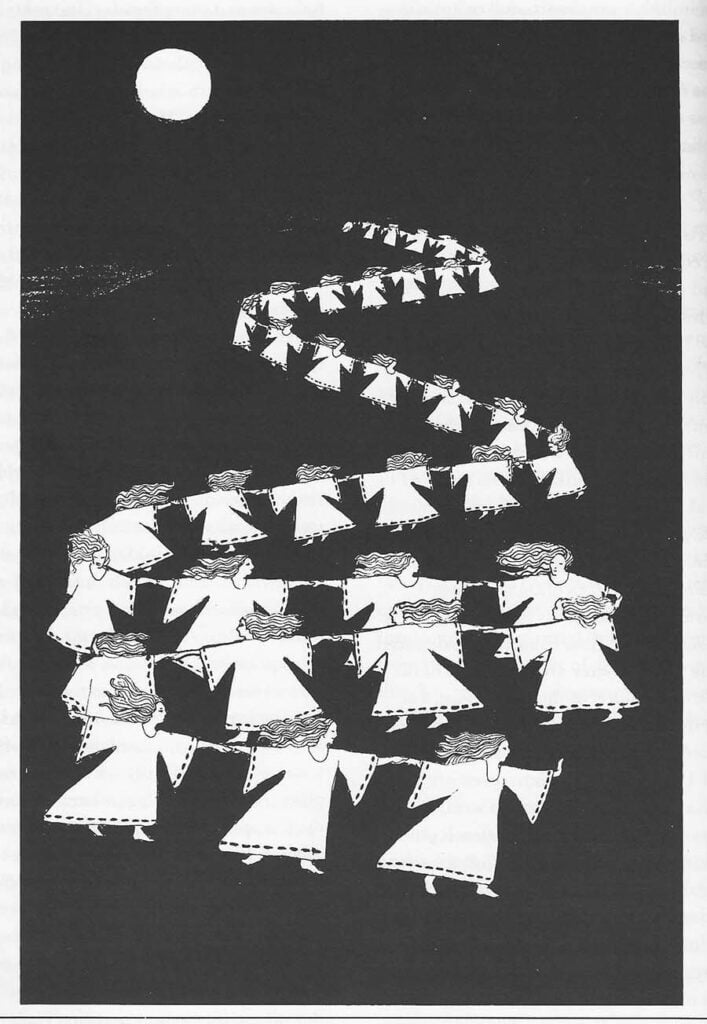
The image of the snake is very interestingly present in all manifestations of Bulgarian folklore. Although there is no dance dedicated to the serpent, such as the totem dance of some Australian aborigines, the symbolism of the serpent is organically woven into the substance of Bulgarian folk dance.
THE horo, the most widespread dance in the Bulgarian cultural tradition, is a closed or open chain created by a group of dancers holding hands. When the chain is closed it is in the shape of a circle, when it is open it becomes an open circle, a serpentine, a spiral or another shape.
The serpent-horo
The open chain of dance horo it is led by a head, commonly known as the "front" or the "head of the horo", its end as the "tail". The horo chain is imagined as a living body. People don't say "we dance", but "thehoro dance". This symbolism comes not simply from the similarity of the snake dance, but also from a notion deeply introjected into people's ideas. This has led to verbal expressions such as “the head and the tail of thehoro“, thought of as the body of a snake, “coiling like a snake”, “thehoro wraps around, snakes, encircles the entire square”, “thehoro folds into nine layers/coils” etc. The stability of these concepts is highlighted by the fact that these idioms refer to the parts of the chain and are not tied to a specific ritual purpose. The dances were danced every Sunday in the horo festivities until 1945. The festivity horo presents a more abstract form of contact with the world of the sacred, a later stage in the development of dance ideology. Later, we will deal with the symbolism of the serpent in the ritual dance proper, especially in the maiden initiation dances, which are performed in the spring.

Lent
The dances horo they were danced on all calendar holidays and every Sunday. In the spring, during Lent according to the Orthodox Christian calendar, dance horo it was forbidden especially if there was a musical accompaniment. Although musical instruments are played by men in the Bulgarian tradition, horo singing is a female activity. During the ritual period of the initiation of the maidens, they were neither sung nor danced horo. Initiation, despite being transformed during different eras, still bears the marks of the archaic models.
The girls' dances were performed in spring on banquet days and on Sundays of Lent. The traditional places where the girls danced were the pastures outside the village and above all the peaks and hills, considered points of contact between the worlds, the realm of the gods: these places, considered sacred, were imbued with mythological meanings since ancient times. This idea is connected with a tripartite model in which the sacred world is at the top. These sacred places in Bulgarian folk culture are usually marked with a stone, a cross, an oak tree, a chapel, the ruin of an ancient sanctuary.
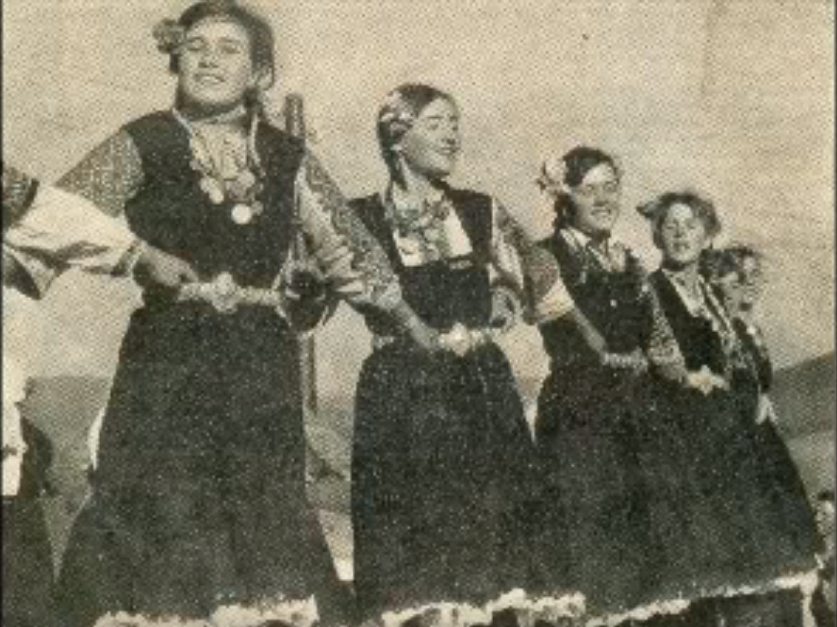
During the spring, in a village in southeastern Bulgaria, the girls conducted their first bouenek, a special dance, from a sacred place outside the village where a throne-shaped stone marked the summer solstice. In some village in South Western Bulgaria, overnight of Tenata nedelya (Dark Sunday), the first Sunday of Lent known elsewhere as the Sunday of San Teodoro or Black Sunday, the maidens went to the cemetery that stands on the hill next to the village. There they lit a fire, sang songs to invoke and awaken spring, and danced around the fire. If a man appeared, the girls were allowed to kill him with burning embers.
In southeastern Bulgaria, on the Holy Forty Days of Martyrs, St. Theodore's Day, First Sunday of Lent and Great Sunday (the Sunday in the middle of Lent) maidens in white coats and loose hair run from peak to peak singing and dancing.
In the various villages, songs and dances were dedicated to a stone, a hill, a forest, a kitten, a tumulus: some of these names show the boundaries in which the rules of cosmic powers manifested themselves through the ritual.
The Bouenek

Il Bouenek, which is not considered a horo, is a particular type of chain dance practiced in Eastern Bulgaria. In Bulgarian science, bouenek is the standard name given to a group of similar dances that share a common musical pulse, often with a marked step iambic. This type of dance is more connected with the symbol of the serpent and is a staple in the spring rituals of maidens. It has many local names: loudata "crazy", tichanitsa "running", byagane "running", louda lazara “mad lazarus”, criva lazara “crippled lazarus”, I write horo “crippled chain dance” e karapilek "black gold".
As the name suggests, the dancers join hands in a long chain and advance with an ordinary gait and a limp, or with a run. This dance known throughout Europe with the generic name of doing it, is normally danced during the carnival season. This type of dance has been remembered since ancient times. The dancing chain unwinds and draws snake-like figures on the ground that bend, stretch, coil, coil, uncoil and pulsate.
This great living organism of maidens holding hands, forming the chain bouenek, has its own plastic movements of breath and impetus. The continuous alternation of the dance stopping in place and then moving forward slowly and quickly with tension and relaxation, in waves of serpentine movements alternating with the coiling and uncoiling of the spiral, creates the sensation of a huge body pulsating with life and radiating power.
The ritual goal is to charge the dancers with energy to allow them to pass into another world, another dimension or quality, become different, which is in fact the goal of initiation.
During Lent, the maidens once danced all day long in the pastures and on the hills. This continuous captivating movement is one of the implicit goals of the bouenek: to awaken in them the vital forces through "life-affirming movements". Spring is the time of the impetuous transformation towards the new life.
It was believed that young girls in their developmental age possessed the magical power to awaken and invoke spring, with the quivering of their bodies and with their voices. During this initiation into being a woman, they sanctified space and time and contributed to the natural course of the change of seasons.
The old Bulgarians say that when the snake bites its own tail, thehoro closes. This happens at Easter. After running the bouenek during Lent, the serpentine chain closes and the maidens "open" Easter with a slow song/lament horo in a closed circle, in memory of the girls and boys who died during the year. the image ofhoro as a snake biting its own tail is a local symbol of the Ouroboros. The image of the serpent encircling the world corresponds to the belief that heaven surrounds the neck, the earth surrounds the waist and the "under ground" the knees.
Wearing the belt was a sign of initiation, maturity and readiness for life here on earth, even in ancient times. Special belts with two horizontally located triangles marking the middle of the figure were found in a painting in a prehistoric cave in Bulgaria.
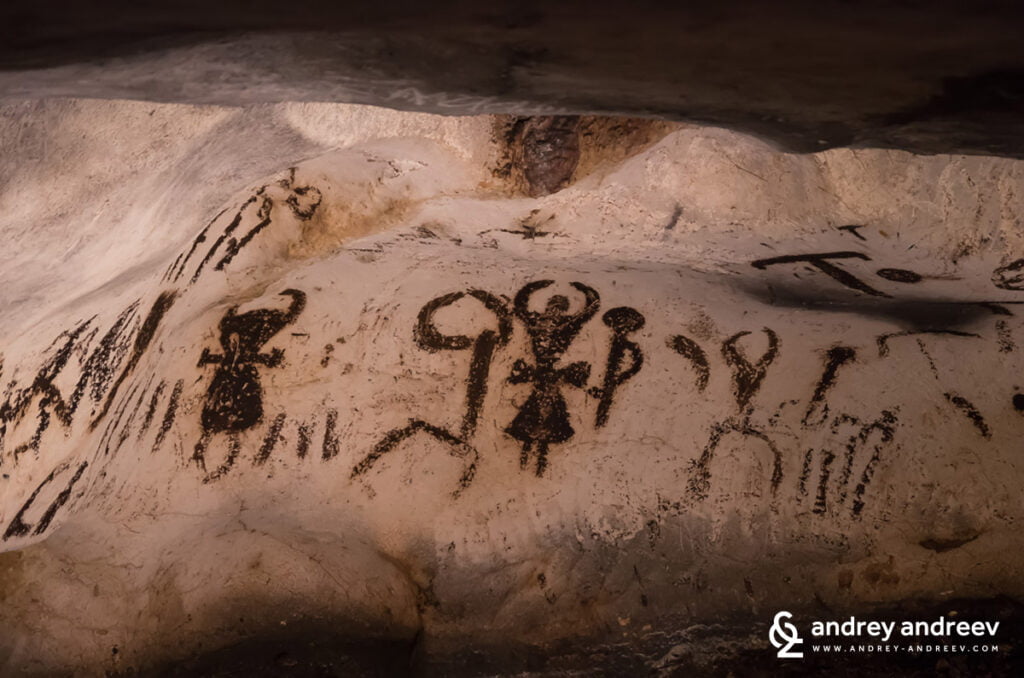
The belt is a basic and obligatory element in the traditional Bulgarian costume for both women and men and is very widespread in thehoro Bulgarian as a holding point. A child never wears a belt. A maiden is given the belt for the first time, in the ideal version of the tradition, for lazarouvan (the day of San Lazzaro), and to a child for coledouvane (Christmas rite). In this sense the belt can be defined as proper to initiation. Therefore, as the principles of the structure of the world are repeated in each person as in a microcosm, the serpent that encircles the world metaphorically also encircles the human being when he reaches maturity.
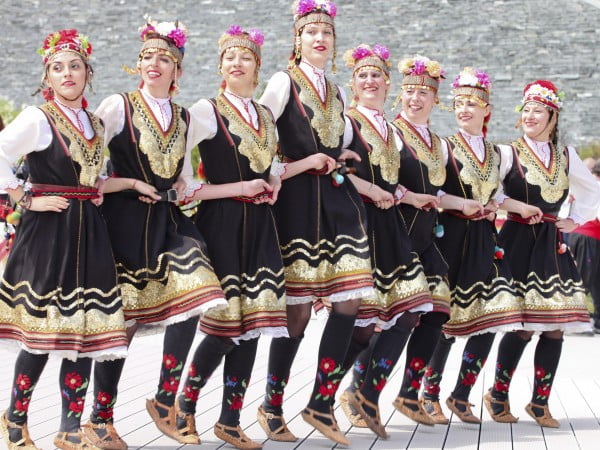
There is a belief that the snake supports the earth and prevents it from destroying itself, just as for the ancient Bulgarians the belt supports the human body. When they join in a horo people say: "We take each other by the girdle to support the body". It is commonly believed that the pack of snakes has healing powers and is worn on the belt. One of the recurring motifs in popular songs is that of a dragon who falls in love with a girl and begins to live with her in a cave. After nine years, when she asks to attend her brother's wedding, he transforms himself into a girdle so he can go to the wedding with her, but she defeats him with her cunning by throwing the girdle into the fire and thus burning the dragon. .
Marija Gimbutas, in The Language of the Goddess (1989:121), describes the serpent symbol as "life force, seminal symbol, quintessence of the cult of life on this earth". In Bulgarian, the words for snake (zmiya) and earth (zemya) have a common root (zumya). In this light we can probably interpret the belief that when on the day of San Lazzaro they dance the bouenek, they must hold each other tightly, because if the chain were to break, the girls who let go would die.
Another belief holds that only the Podnitsa (a clay vessel for making ritual bread) made from new earth on St. Jeremiah's Day (May 1) can hurt a dragon. That day was celebrated in honor of snakes.
In the ritual preparation of the Podnitsa, the women knead the earth by dancing a horo special barefoot in a circle while singing. Women walking on the new land of podnitza will not be bitten by snakes and no snake will enter houses with their podnitsa. It was believed that each house has its own called snakes stopanka, which is also the name used for the mistress, the Lady of the house. Metaphorically speaking, every stopanka she is a goddess in the microcosm of her home. She is the one who keeps the fire burning, the one around whom the maidens of the Lazarki they dance “all'ape”. She is the one who, when she decides to marry a son, welcomes and guides the bride into her home with bread and honey, water and fire.
The mother-in-law played a decisive role in Bulgarian marriage rites. Of her Welcomes the bride to her new home, dancing in front of her with lighted candles. She hands her a bowl of honey which the bride distributes on the four corners of the door before entering. The mother-in-law rekindles the fire entering the room and gives the blessings: "May there be as many sparks as life, health and fertility in this house". Then the mother-in-law handed the low end of the hearth chain to the bride, while she herself guided the horo around the hearth. In her raised right hand she held the bowl containing the bread and honey, and with her left hand she grasped the bride's belt. The bride in her turn held the chain in her right hand while grabbing the groom at her belt with her left. From the groom onwards all the participants held each other by the belt.
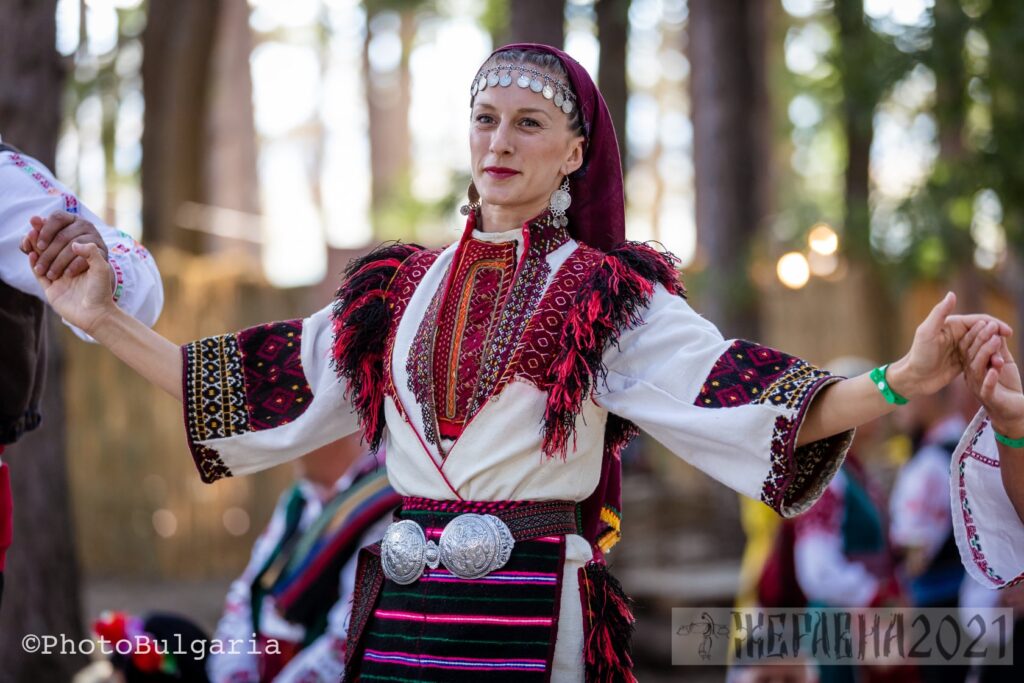
The serpent symbol, itself multipurpose, becomes understandable in dance when its different manifestations in folklore are recognized. Snakes are present in fairy tales, songs, rituals, concepts and beliefs, in the ornaments of shepherds' sticks, in wedding trunks. Ritual dance, which expresses the primordial rhythmic pulsation, is equally multipurpose since it has developed the symbolic power contained in archaic myths. This development has led to different but mutually complementary forms. This is because the merging and development of symbols and meanings in popular culture is a natural phenomenon.
In the bouenek dance added to the symbolism of the snake we find the evocation of the bee. The buenek twists into a spiral, but before the maiden who guides it, called herself a bounek, begins to unwind the spiral, the dancers move as if they were a swarm of bees.
The girls' rituals coincided with Lent, during which it was forbidden to dance the horo and devote oneself to bees. During these meetings the wool was spun. The strong function of awakening nature was retained. The esoteric stage, the period before Lazarouvane (the Saturday before Palm Sunday) was dominated by preparation and gathering strength through songs and dances held in homes, such as a presentation at the Lazarouvane. This however was a ritual that entered much more recently and very distant from the awakening of nature, from resonating with nature. The dominant focus of the maidens' song and dance was transferred to the consecration of the house and its lords. In other words, the harmony between man and nature moved into a harmonization within human society – through an affirmation of hierarchy as its intrinsic order. Through the exchange of gifts, the girls gave their blessing to the lords of the house, and the Stopanka gave the girls an egg (another complex and interesting symbol).
Lazarouvane
Lazarouvane it was the biggest girls' party, which crowned the Lenten cycle of girls' games. If their games, the races on the fields and hills of Lent suggested the maintenance of the memories of female mysteries, Lazarouvane it was dominated by the social aspect, by premarital initiation. It was a universal law that no girl could marry without having been one Lazarkaotherwise she would have been kidnapped by a dragon.
During the Lazarouvane, Lazarki they danced in the courtyards of the houses. The house with the courtyard had a predominant role in the tradition: it was a model of the universe. The outdoor races and dances were relocated inside the courtyards and cohorts, thus allowing the Lazarki to dance and sing personally for the unmarried girls and boys and for all the members of the family, and then to develop songs for the different occupations: the priest, the pastor, the mayor, the scribe.
Two groups of three Lazarki each sang while a couple of Lazarki she danced among them from opposite positions. In some versions they described circular patterns on the ground. In others they moved back and forth, met and separated. The dance focused on hand movements, and waving handkerchiefs Lazarus in different ways and directions. This waving of handkerchiefs describing circles, eights and other figures was the secret language of Lazarki.
Despite the congruences of drama and door-to-door going, this dance was very different in western Bulgaria. And if the dramaturgy of the ritual is more or less unified at the national level, regional differences suggest the retention of traces from older and prehistoric local rituals.
the ape
During the Lazarouvane in western Bulgaria, the group of girls performed a special dance dedicated to bees in each courtyard. This dance was done by a circle of girls holding hands going around the Stopanka.
The heads of Lazarki they were adorned with flower crowns, a box was fixed at the back of the top of the head in the hair gathered in a bunch, and quills pointing downwards were inserted into it. Feather grass (a special dry grass with long thin leaves like spider's web, which looks like a fluffy cloud) was pinned just below the fake bun along with a peacock feather. On the front a cap, a crown of flowers sewn on the fabric. From this hung other flowers, pennies, garlands, ribbons, beads and silver coins attached to 22 thin braids. And lastly, on the forehead the Lazarka placed a crown of colored beads.
During the dance, the Stopanka she tore off bits of hair and placed them in an earthenware bowl filled with water, saying: “As the leaves fall from the box, so the bees will swarm”.
And the girls replied:
Millennial honey bee
who gather the flowers of the fields,
and honey in the woods,
that you fly home to leave him,
that you fly from the maidens,
from maidens, from their feather grass.
This intriguing form of addressing bees, accompanied by epithets, is common in traditional literature. The bee is described as the one who makes honey, but also as the "Ancient One" of the Mythic Age, the millennial bee.
The dance was performed with a magical rotation, both of the circle and of each girl. That is, a step forward with simultaneous rotation of the right shoulder so as to twist the whole body to the left. They explained that dancing in a circle allowed the bees to fly around the hives as the circle spun. In this case the shape of the circle is part of a specific configuration of meanings: the round dance around a sacred tree, a tomb, a boulder or a sacred object is an ancient feminine activity.
By this we are not arguing that this dance refers to an initiation into the Great Goddess in her hypostasis as a bee, what we have here is a dance and ritual which is part of what is termed classic Christian "folklore" in its ideology official and in its medieval motifs. Nevertheless, some analogies can still be drawn, given that in the development of culture nothing disappears but is simply transformed and saturated by new meanings, or retains the ancient meanings but dresses them in new forms.
The girls were taking part in the ceremonies of Saint Lazarus Day for the first time. In an etiological legend, the devil splits the bee along the waist because the bee warned God not to allow the sun to marry: if many suns were born everything would burn and there would be famine. The devil is the negative Christian interpretation of the worldly. As we have already seen, wearing a belt indicates belonging to the earth as something in between. The bee traditionally lives in the crevice of an oak tree, model of the world tree. Her thin waist, in being the hypostasis bee of the Great Goddess, is probably intended as a girdle signaling her belonging to the mundane, the middle realm, and as a vow to serve here on earth.
It was a common belief that in this moment of transition the Lazarka, in her temporary role of a priestess, possessed supernatural powers and could consecrate and bless a house, lords and children, fields and pastures, with song and dance. In return, she was recognized as having become a woman fit for marriage.
During the dance of the maidens, the Stopanka he stood inside the circle and gathered feathers and herbs. The song says that after leaving the collected honey, the bee hovered to collect more from the girls' flowers.
As already mentioned, the Lazarouvane they are a set of spring ritual dances, they are danced during Lent and end at Easter; they are based on an ancient female initiation ritual, they include rites of "pre-vision" and laments, as for example in the ritual burial of the puppet of Lazarus: "the killing of Lazarus". All these dances therefore echo the myth of the deity who dies and is reborn. A frog is placed on the basin of the Peperouda, and a turtle on Drelyovitsa (a character from the evocation of Easter).
Butterfly-frog
Peperouda (butterfly) was a widespread ritual for the rain, done at a time when the waters had to manifest themselves in abundance and the plants were in full bloom, when fruits and cereals had to develop and ripen. The singing girl is also called Peperouda. The song goes:
Peperouda naked and barefoot
fly and dart on the water.
In the oldest version of the ritual, the Peperouda she is naked and barefoot (in folklore a naked body is associated with nature, a clothed one with culture). Her hair is loose and her body is covered with vegetables to emphasize that she belongs to the world of nature. She holds twigs in her hand, and frogs are tied to her head and waist.
Dance by shaking and shaking the body. She runs forward, backward, in circles. The twisting of her body, her flowing hair, the green twigs flapping like wings on either side of her staged mythical beliefs. It was a physical activity aimed at bringing balance to the relationship between the human and the cosmos. The movements sought to resonate with natural rhythms to contribute to the cyclical renewal of nature and unleash the forces of new life in nature and among humans.
The various personifications of Mother Earth, as creator of forests and waters in a time when the world was created by dance, are expressions of female sovereignty in nature during different stages of agrarian society. A fairy tale tells of the Frog Queen who danced and danced, tossing and turning. When she raised her right hand she created forests and streams. When she lifted her left hand the birds began to fly.
The same ritual was repeated in each courtyard. The Peperoudarki (the group of girls accompanying the Peperouda) entered singing and formed a circle. On their side the Peperouda began to dance. Simultaneously, the Stopanka he carried a cauldron full of water and poured it first on the Peperouda and then on the other barefoot girls. Immediately after, the Peperoudarki they started to dance bouenek, trampling the spilled water, fidgeting and shouting with euphoria. Both ritual euphoria and the pouring of water were ways of expressing abundance and fertility in the language of folk art. The same idea is found in the myth of Zeus, who transforms himself into golden rain to wash Danae. Similarly, in some Bulgarian villages, young people hid behind fences to wait for the procession of girls and Peperouda, ready to throw water balloons at them to drench them in a puddle.
In the rain ritual, the Peperouda recites the myth of the deity dying and rising from the world of the dead, or of the drought caused by the disappearance of the deity and which only she can influence, as a mediator.
The bee and the butterfly
The figures of the bee and the butterfly are interchangeable with those of the Thunderer and the bringer of rain: therefore the ritual of the rain of the Peperouda was not rigidly distinguished from Lazarouvane. This non-differentiation can be traced on several levels. First, the level of dance activity, at which the Peperouda , Lazarka they weren't much different. Second, the level of accessories, one waves twigs, the other handkerchiefs. Thirdly, the provenance of the dance: in Eastern Bulgaria the bouenek was the main dance of the Lazarki, but in some places also i Peperoudarki they danced the bouenek. As already mentioned, in one of the versions the San Lazzaro/bouenek it coils into a spiral and moves like a swarm of bees. In contrast, at the end of the dance, the Peperoudarki they roll up in a spiral while the Stopanka pour water on them.
At the end of the rite, the vegetables with which the Peperouda is covered are soaked, "drowned" in the water. After the Lazarouvane, the Lazarki choose one Koumitsa (godmother), whose mother will prepare a commemorative table on Easter Sunday. The choice was made by throwing small garlands into the water of a river and waiting for the one that emerged first. In fairy tales this is transformed into the topos of the dragon who claims a maiden every year. After a Koumitsa is chosen, someone appears to direct the horo out of the river, just like the prince defeating the dragon appears in fairy tales. From that day forward the girls will be able to get engaged without fear of being kidnapped by a dragon.
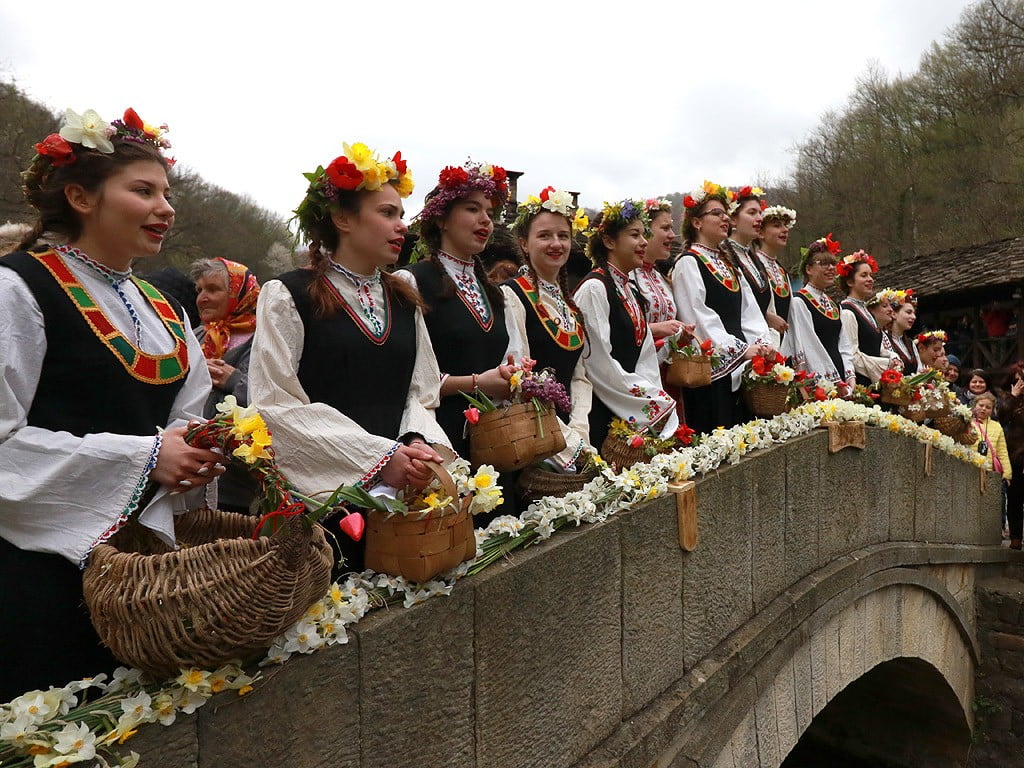
Our research is based on materials that until the mid-twentieth century still existed as a ritual system associated with holidays. and it was very much alive in the memory of those we interviewed. Thus we can trace the stability of Old European symbolism even in this "living" cultural system of folk dance, which was formed in Old Europe and survived in the patriarchal agricultural society. The archetypal figures have been transformed, reshaped and converted by the ideological paradigm shift, but have invariably retained elements of their original source.
Only the study of the dances determines whether, for example, we will interpret the couple Bouenek e Bulka as a matrimonial game, which prepares the young people for marriage, or if we will interpret the initiation rites as premarital socialization customs or as survival and re-enactment of the Hieros Gameos. On the other hand, every marriage in folklore recites hierogamy and every bride is a queen.
This holistic study, from different angles and aspects of research, reveals a hierarchical system of meanings, which vibrate at different levels and reconcile conflicting ideologies. Today we are able to decode these ritual dances and see how the sacred can manifest itself on a social level, and how the myth can be part of everyday life.
Adapted from From the Realms of the Ancestors. An Anthology in honor of Marija Gimbutas
Translation from English by Alessandra Fumai
The author: Alessandra Fumai
from a very young age she studied and practiced songs and dances of the world. She becomes a trainer and interpreter specializing in contemporary African dance, dance theater and polyphonic singing. At the same time, you carry on your studies in cultural anthropology at the Universities of Bologna and Turin. She graduated in Gender Anthropology and in Anthropology of the body and politics, after a research thesis in Colombia in 2020.
From that moment he deals with directing and operates a fusion between anthropology and dance by staging his three-year thesis in the show “Pelle. Il pubis Nudo”, which deals with issues such as aesthetic consumerism and gender-based violence. For about six years she has been working with women of all ages through the laboratory "Il Corpo Abitato", created together with Irene Mastrocicco, while continuing her research on the feminine, in its historical, sacred and contemporary expressions.
Article cover image:
The dancers of Ruvo, tombstone made in the early 15th century BC. C., proposes a geranos, the ancient circular dance that imitated the flight of cranes; found in Ruvo di Puglia on November 1833, XNUMX, now kept in the National Archaeological Museum of Naples.

